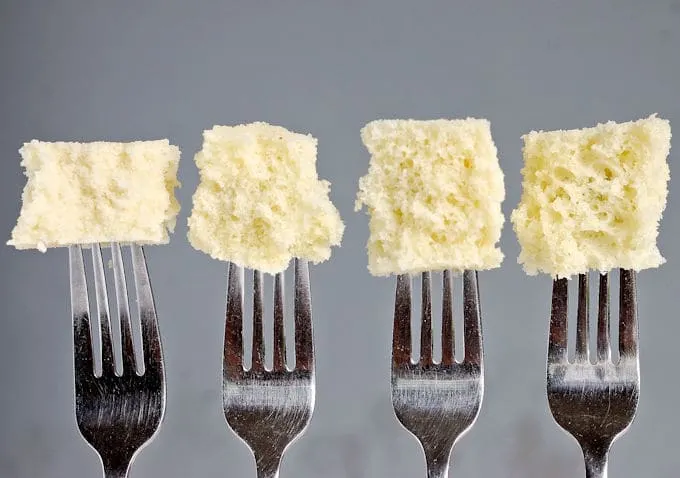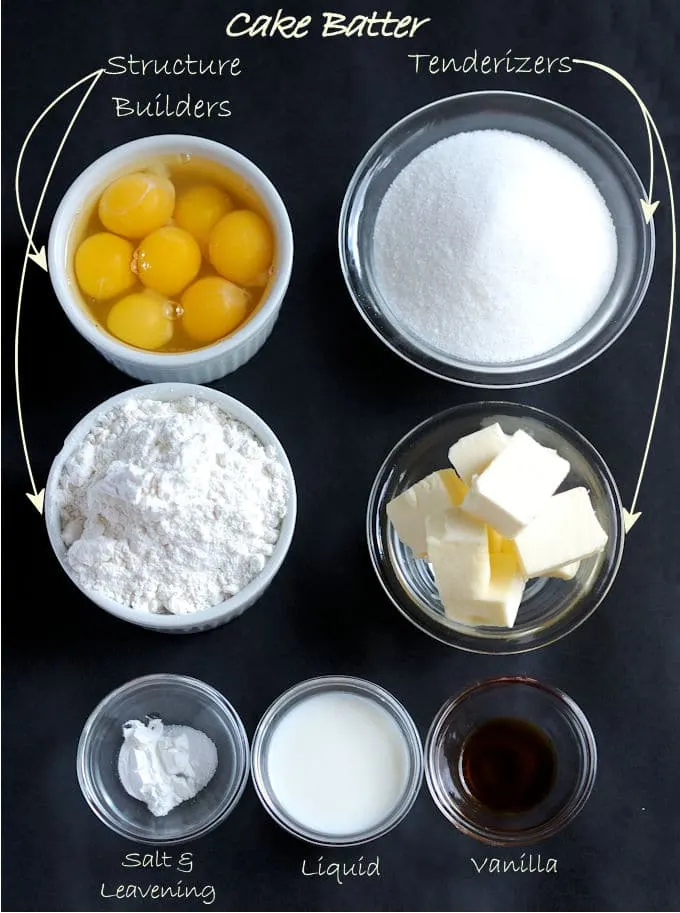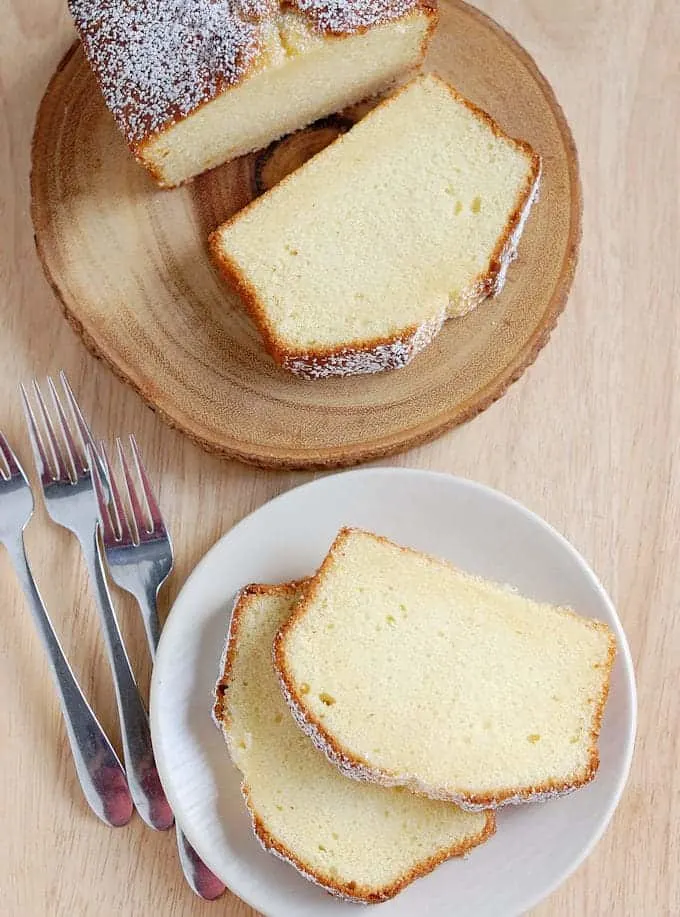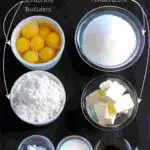How to create the best Cake Recipes
In this article we’ll learn how to create a great cake recipe using the Baker’s Formula.
The information in this article is the culmination of all our Cake Batter classes, but can also stand alone. If you’d like to follow the classes in order visit the Baking School/Science of Cake Batter page.

Use the Baker’s Formula for making the best cakes
To make a perfectly moist and soft cake you’ll first need to understand the concept of the baker’s formula.
A successful cake recipe balances the ingredients that strengthen the cake structure (flour and eggs) with the ingredients that weaken and tenderize the cake structure (sugar and fat).
The Baker’s Formula is used to calculate the proper percentage of each ingredient for a successful recipe. The flour in the recipe is designated at 100% and all the other ingredients are designated relative to the flour. This is a very important point, so keep it in mind as we get deeper into it.

Lean Cakes vs. High Ratio Cakes
About Lean Cakes:
A pound cake recipe made with equal weights of flour, sugar, butter and eggs is a so-called “lean cake”. A “lean cake” has a very simple 1:1 formula balancing the structure-builders with the tenderizers.
The only liquid in the original recipe comes from the eggs (egg whites are 90% water).
About High Ratio Cakes:
While a lean cake is made with equal proportions of flour and sugar, a high ratio cake has a higher proportion of sugar to flour.
In order for a high ratio cake to have good structure we need to adjust some of the other ingredients to keep the cake formula balanced.
Liquid brings together the structure builders and the tenderizers in the batter. The liquid activates the gluten and swells the starch in the flour. The liquid also dissolves the sugar and helps disperse the fat throughout the batter and, of course, provides moisture.
If we use cake flour, with it’s finely ground starch that absorbs extra moisture, we can change the Baker’s Formula to allow for more liquid.
We can also use an emulsifier in the batter to help bind the liquid and fat in the batter. This allows for even more liquid in the recipe, and thus more sugar since you need liquid to dissolve sugar.
A cake made with cake flour and an emulsifying agent can now be higher than 1:1 (sugar:flour) without compromising the structure.

Adjust the Baker’s Percentages for A Better Pound Cake
I used the original quatre quarts pound cake recipe as the basis for all the cake batter classes because the simple 1:1:1:1 ratio makes it very easy to measure changes. So that is the recipe I will use to show you how to use the baker’s formula to improve a cake recipe.
The first step was to lighten the crumb a tiny bit, so I added a little baking powder to the recipe. A pinch of salt and a teaspoon of real vanilla extract were added to enhance the flavor.
Now that the cake was lighter I wanted to sweeten things up a bit. The Baker’s Formula for a high ratio cake allows for up to about 140% of the weight of sugar to flour. I found in my testing that I like pound cake with a ratio of 125% sugar to 100% flour. With this in mind I increased the sugar in the recipe from 8 oz to 10 oz.
I also wanted to add a little extra liquid for moistness, so I needed an emulsifier in the batter. Vegetable shortening will act as an emulsifier, but I prefer an all-butter cake for the unparalleled flavor.
Instead of using shortening in the batter, I used a few extra egg yolks because yolks are great emulsifiers and also add a little extra fat and flavor to the batter. I changed the 8 oz of eggs in the recipe to 3 whole eggs and 4 extra yolks.
Now that we have cake flour and emulsifying eggs yolks in the recipe we can add a little more liquid for additional moisture. I added whole milk as the liquid for a basic pound cake recipe.
The revised recipe makes the perfect melt-in-your-mouth buttery pound cake.
Adjust Baker’s Formula for A Lighter Vanilla Layer Cake
Of course the Baker’s Formula is not only useful for perfecting pound cake recipes. We can continue to test the limits of the structure builders and tenderizers to create a whole world of cake recipes.
I’ll give you another example. As I said, the perfect pound cake should have a dense, buttery texture that doesn’t need any icing at all. But a Vanilla Layer Cake is meant to be filled and iced with frosting. So a great Vanilla Layer Cake should be a little lighter and softer than a pound cake.
As a comparison, let’s look at the Baker’s Percentages for my Pound Cake Recipe vs. my Vanilla Butter Cake Recipe:
| Pound Cake | ||
| Flour | -8 oz | 100% |
| Fat | -9 oz | 112% |
| Sugar | -10 oz | 125% |
| Eggs | -8 oz | 106% |
| Liquid | -7.5 oz (w/eggs) |
| Vanilla Cake | ||
| Flour | -9 oz | 100% |
| Fat | -10.6 oz | 116% |
| Sugar | -12 oz | 133% |
| Eggs | -6.6 oz | 73% |
| Liqui | -12 oz (w/eggs) |
Ok, that’s a lot of information. But lets look at the percentages. (Remember: all percentages are relative to the weight of flour in the recipe.)
By just looking at the percentages you can guess that the vanilla cake will be a little more tender (more sugar and fat), a little sweeter (more sugar) and a little more moist (more liquid) than the pound cake.
The vanilla cake recipe also has more leavening and I whip the whites before adding them to the batter. So the vanilla cake also has a more open and light crumb than the pound cake.
Whew!!! So, all those small changes to the basic formula created a lighter, sweeter and softer cake. That’s just what I want for a cake that will be filled and iced with buttercream.
The takeaway here is that every cake recipe in the universe is some variation on this formula. The type of fat or liquid can change, additional ingredients can be added, but it’s always about the balance between structure and softness.
It’s the variations that create the myriad of cake recipes that we can invent and perfect.


Please share pound cake or bundt cake recipe using honey or sugar replacement.
How can we analyse the bakers formula for the eggless versions using vegetable oil instead of butter.
Thank you so much for this valuable information! I’m curious as to how the addition of mini chocolate chips would affect the cake as well as baking it in round cake pans to make more of a layered “birthday” style cake.
Here’s a recipe for Chocolate Chip Cookie Cake that explains how to add mini chips to a basic vanilla cake.
What shd be percentage of liquid in the tea cakes or liquid to flour?
I am so happy i found your site. I love experimenting but results are not always edible! Knowing the science behind is fascinating and makes sense now. Thank you so much for your tireless patience in answering questions. I will certainly buy your book in on UK Amazon.
If I may ask one please?
I have lots of ripe bananas and wondered how to adjust the recipe to accommodate them and end up with a nice textured cake?
Many thanks